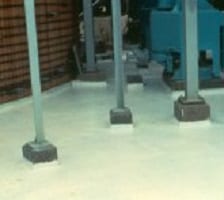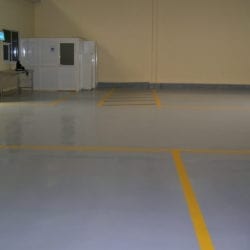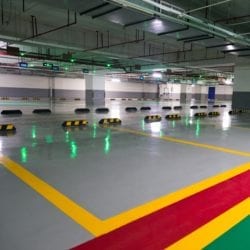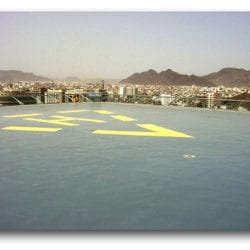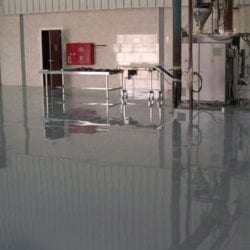USES
CHEM-HCR coating offers a high chemical resistance and is widely used in the following industries:
- Pharmaceutical Plants and Medical Laboratories
- Car Production Facilities and Warehouses
- Aircraft Hangars and Maintenance facilities
- Chemical Factories
- Leather Tanning Industries
- Detergent Factories
- Paper and Textile Industries
- Ideal for Kitchens, Dairies, Computer Rooms and Any Areas Requiring an Attractive Hygienic Floor and Wall Coatings.
- Battery Charging Areas
TECHNICAL
Technical Data for Unmixed Parts
| Property @25°C (77°F) |
Resin – Part A
|
Hardener – Part B
|
Test Method
|
| Solids |
100 % |
100 % |
–
|
| Color |
Clear |
Grey |
–
|
| Density, Lb/Gal (Kg/L) |
< 9.32 (1.12) |
< 13.0 (1.57) |
ASTM D-1475 |
| Mixing Ratio A : B |
1 : 1 By Volume |
–
|
| Shelf Life |
2 years |
2 years |
–
|
Technical Data for Mixed Parts
| Property (Mixed A & B) |
Value @ 25°C (77°C)
|
Test Method
|
| Density, Lb/Gal (kg/L) |
11.4 (1.37) |
ASTM D-1475 |
| Viscosity, cP |
4000 |
Brookfield |
| Gel Time @ 60 grams, minute |
28 |
ASTM D2471 |
| Pot Life @ 3 Oz (90 milliliter), minute |
25 |
–
|
| Shore Hardness @ 3 Days, D |
84 |
ASTM D-2240 |
| Compressive Strength @ 7 Days, Psi (MPa) |
12038 (83) |
ASTM D-695 |
| Bond Strength to concrete |
Concrete Failure |
ASTM D-4541, Method C |
| Water Absorption 24 hrs, % |
0.09 |
ASTM D-570 |
| Final Cure, day |
7 |
–
|
Chemical Resistance: Tests are performed according to ASTM D543 – Practice A (Immersion test for 7 days at 77°F/25°C). The fully cured product is resistant to:
- Water (Distilled, Tap, chlorinated, sewage, sea)
- Sulfuric Acid 70%*
- Phosphoric Acid 85%*
- Sulfuric Acid 50%
- Acetic Acid 25%
- Citric Acid 30%
- Caustic Soda 50%
- Hydrochloric Acid 37%
- Diesel
- Hydraulic Oil
- Xylene
- Gasoline
* Change in color only (no change in mechanical properties)
Refer to manufacturer for resistance of other reagents.
APPLICATION
Limitations:
| Minimum substrate temperature |
41°F (5°C) |
| Maximum permissible moisture content of concrete substrate |
5 % |
| Minimum temperature of product for mixing |
50°F (10°C) |
| Minimum temperature for curing |
41°F (5°C) |
| Maximum temperature exposure for prolonged period |
149°F (65°C) |
Coverage: 1 Gallon of CHEM-HCR will yield 20 mils (500 microns) when applied at 80 ft2 / Gallon (1.96 m2 / Liter).
Surface Preparation:
Concrete Substrate: New concrete substrate should be 28 days old and must be a minimum of 3625 Psi (25 N/mm2) compressive strength concrete. The Ensure concrete is free from excessive laitance, grease, oil, releasing agents, curing compounds, etc. The concrete should be sound and dry. Moisture content of the concrete substrate should be less than 5%. Any damages in the substrates such as honeycombs, bleeding, segregation, and structural cracks should be repaired using appropriate repair methods prior to coating. Pinholes, blow holes, small voids in concrete surfaces must be filled with epoxy based pinhole filler like CHEM-VERSATILE to achieve a neat smooth uniform finish.
Steel: The base metal should be free from rust, scales grease, oil, and any other impurities, which impairs the strong adhesion of coating. Corroded steel should be shot blasted to Swedish Standard SA 2½ achieving bright metal surface. Where shot blasting is impractical, pre-treatment may be carried out using needle guns, tap hammers, rotary wire brushes fitted to grinder or drill, mechanical grinding, etc. Cleaning with solvent is advisable to ensure surface is free from grease or oil. The coating work should be carried out immediately or at maximum 2 hours after pre-treatment of steel surfaces.
Product Preparation: Store product at 70°F (21°C) during application and for at least 2 days prior to use. Low temperature will increase the viscosity of the product causing poor coverage and retarded cure. Also, CHEM-HCR should be protected from extremes of temperatures which may cause in consistent workability, finish and cure times of the mixed material.
Use of Water Moisture and Vapor Blocker: Application of moisture blockers like CHEM-CRETE SOFIX CCC100 and CHEM-CRETE SOFIX CCC700 prior to application of CHEM-HCR onto concrete surfaces is recommended. The use of these moisture blockers will extend the service life of the coating by eliminating moisture and vapor associated problems like; coating degradation, coating de-bonding and blistering. Water moisture transmission through concrete floors where CHEM-CRTEE HCR will be applied should be less than 5 Lbs per 1000 ft2 per 24 Hours based on ASTM F1869 (Standard Test Method for Measuring Moisture Vapor Emission Rate of Concrete Subfloor Using Anhydrous Calcium Chloride), in case transmission rate equals or greater than 5 Lbs per 1000 ft2 per 24 Hours, such moisture blockers should be sued. Refer to these products’ data sheets for more information about how to use these products.
Mixing: CHEM-HCR is supplied it two pre-weighed parts resin and hardener. No additions or omissions are required. Stir each part separately. Pour part B (hardener) into the container of part A (resin). Mix both parts using slow speed hand drill fitted with a mixing paddle attachment. Carefully scrape the sides and bottom of the pail during mixing. Blend for 3 minutes until achieving a uniform color and consistency. Mixed epoxy must be processed within the pot life. Mixed epoxy will cure much faster in hot weather. Large batches of mixed epoxy will cure much faster than small batches. Always keep the mixing time the same for all batches to ensure a uniform consistency when the product is applied.
Application:
As a Protective Coating:
First Coat: Apply the mixture onto the pre-treated substrate using a good quality roller or brush being careful to leave no pinholes or breaks into the coating. With rough concrete surfaces, work the coating well into the surface using a stiff nylon bristle brush. Spread the mixture uniformly at an average coverage of approximately 200 ft2 / Gal (5 m2 / liter). This will yield a first coat with 200 microns dry film thickness (DFT).
Second Coat: Prior to the application of finishing coat, examine the surface for defect signs like pin holes, etc. Where pinholes are evident, these should be smoothened using Epoxy based pinhole filler. Apply the second coat in a different color to ensure a complete coverage, which allows an optical control of the application.
The second coat should be applied between 12-36 hours after the application of the previous coat, the higher the ambient temperature then the shorter the re-coating interval period. Should there be any delay in applying the second coat than the specified re-coating interval period, then the previous coat must be thoroughly abraded to give an adequate mechanical key.
Apply the second coat using good quality roller or brush being careful to cover the complete area without breaks in the coating. Spread the mixture uniformly at an average coverage of approximately 200 ft2 / Gal (5 m2 / liter). This will yield a second coat with 200 microns dry film thickness (DFT). Total coating thickness is 400 microns dry film thickness (DFT).
CHEM-HCR mortar and lining system: CHEM-HCR can be mixed with silica sand to produce a mortar screed or with fiber mat for a lining system.
Cleaning: remove uncured CHEM-HCR from tools and equipment with suitable solvents such as Xylene, Toluene or CHEM-CRETE BLENDED SOLVENT immediately after use. Cured material may only be removed mechanically.
CHEM-HCR slip-proofing coating: As a slip-proofing coating broad cast clean, dry, 20-50 mesh sand and 97% silica into first coat of CHEM-HCR while still wet until only dry sand is visible. After a cure of 16-24 hours, sweep excess sand. If desired, a second coat can be applied to seal the surface.
Note: CHEM-HCR can be applied in 8 – 10 mils (200 – 250 microns) vertically.
Curing: Allow the coating system to cure for minimum 24 hours prior to subjecting it to use for light traffic. Heavy traffic and chemicals should not be allowed until after 7 days.
STORAGE
The product can be stored for minimum of twelve months at temperature from 50°F to 95°F (10°C to 35°C) in the unopened original packaging. Protect from direct sunlight.
SAFETY
After hardening thoroughly, CHEM-HCR is physiologically harmless. Keep the resin and hardener away from the eyes mouth and skin. Do not breathe in the vapors. The uncured mixture can cause irritation of the skin. For best protection, wear rubber or plastic gloves. In case of contamination, wipe away resin or hardener immediately from the skin using paper towels and then wash with soap and water or hand cleaning detergent. Empty resin and hardener cans must be disposed according to local city code or regulations. Under no circumstances empty cans should be used to store food or drink even if they have been thoroughly cleaned. Follow all cautionary direction as printed on container’s labels.
WARRANTY
LIMITED WARRANTY: International Chem-Crete Inc. warrants that, at the time and place we make shipment, our materials will be of good quality and will conform to our published specifications in force on the date of acceptance of the order.
DISCLAIMER: The information contained herein is included for illustrative purposes only and, to the best of our knowledge, is accurate and reliable. International Chem-Crete Inc. is not under any circumstances liable to connection with the use of information. As International Chem-Crete Inc. has no control over the use to which others may put its products, it is recommended that the products be tested to determine the suitability for specific applications and/or our information is valid in particular circumstances. Responsibility remains with the architect or engineer, contractor and owner of the design, application and proper installation of each product. Specifier and user shall determine the suitability of the product for specific application and assume all responsibility in connection therewith. AM300311.

